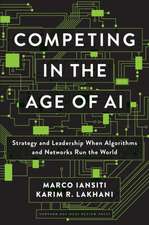Deep Learning Architectures: A Mathematical Approach: Springer Series in the Data Sciences
Autor Ovidiu Calinen Limba Engleză Paperback – 14 feb 2021
This book can be used in a graduate course in deep learning, with the first few parts being accessible to senior undergraduates. In addition, the book will be of wide interest to machine learning researchers who are interested in a theoretical understanding of the subject.
| Toate formatele și edițiile | Preț | Express |
|---|---|---|
| Paperback (1) | 442.20 lei 6-8 săpt. | |
| Springer International Publishing – 14 feb 2021 | 442.20 lei 6-8 săpt. | |
| Hardback (1) | 513.51 lei 3-5 săpt. | +72.95 lei 6-12 zile |
| Springer International Publishing – 14 feb 2020 | 513.51 lei 3-5 săpt. | +72.95 lei 6-12 zile |
Preț: 442.20 lei
Preț vechi: 552.75 lei
-20% Nou
84.62€ • 87.43$ • 70.39£
Carte tipărită la comandă
Livrare economică 20 martie-03 aprilie
Specificații
ISBN-10: 3030367231
Pagini: 760
Ilustrații: XXX, 760 p. 207 illus., 35 illus. in color.
Dimensiuni: 178 x 254 x 48 mm
Greutate: 1.09 kg
Ediția:1st ed. 2020
Editura: Springer International Publishing
Colecția Springer
Seria Springer Series in the Data Sciences
Locul publicării:Cham, Switzerland
Cuprins
Recenzii
Notă biografică
Textul de pe ultima copertă
This book can be used in a graduate course in deep learning, with the first few parts being accessible to senior undergraduates. In addition, the book will be of wide interest to machine learning researchers who are interested in a theoretical understanding of the subject.
Caracteristici
Descriere
This book describes how neural networks operate from the mathematical point of view. As a result, neural networks can be interpreted both as function universal approximators and information processors. The book bridges the gap between ideas and concepts of neural networks, which are used nowadays at an intuitive level, and the precise modern mathematical language, presenting the best practices of the former and enjoying the robustness and elegance of the latter.
This book can be used in a graduate course in deep learning, with the first few parts being accessible to senior undergraduates. In addition, the book will be of wide interest to machine learning researchers who are interested in a theoretical understanding of the subject.


























